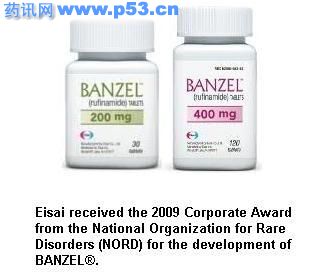|
北美的Esai公司宣布,美国食品药物管理局(FDA)核rufinamide (Banzel)作为4岁以上小孩及成人与痉挛相关之雷葛氏症候群(Lennox-Gastaut syndrome,LGS)的辅助治疗。
By Susan Jeffrey Medscape Medical News November 25, 2008 — Esai Corporation of North America announced US Food and Drug Administration (FDA) approval for rufinamide (Banzel) as adjunctive treatment of seizures associated with Lennox-Gastaut syndrome (LGS) in children aged 4 years and older, as well as adults. The product will be available for this indication in January 2009, a statement from Esai notes. However, Esai received a complete response letter for rufinamide as adjunctive treatment for partial-onset seizures with and without secondary generalization in adults and adolescents 12 years of age and older, indicating the FDA review is complete and this application is not ready for approval. The drug is a triazole derivative that is structurally unrelated to currently marketed antiepileptic drugs (AEDs), the statement says, and is believed to act by regulating the activity of sodium channels in the brain. LGS Difficult to Treat Lennox-Gastaut syndrome is characterized by multiple and frequent seizures, the statement notes. It accounts for up to 4% of all childhood epilepsy cases, and approximately 300,000 children under the age of 14 years have epilepsy in the United States. Onset of LGS is usually between 1 and 5 years of age, and approximately 3% to 7% of patients die within a mean follow-up of less than 10 years. The condition is difficult to treat, often requiring multiple drugs, and manifests a variety of seizure types. Tonic, atonic, and absence seizures are the most common, although tonic-clonic, myoclonic, and other seizure types may occur. The multiple types and frequency of seizures can lead to developmental delays and behavioral disorders. Approval as adjunctive treatment of seizures in LGS is based onasingle,multicenter, double-blind study comparing rufinamide with placebo in 138 male and female patients between the ages of 4 and 30 years(GlauserTetal.Neurology2008;70:1950-1958). Patients were included if their seizures were inadequately controlled on 1 to 3 concomitant stable-dose AEDs; each patient had to have at least 90 seizures, including both atypical absence seizures and tonic-atonic seizures, in the month prior to study entry. After completing a 4-week baseline phase on stable therapy, patients were randomized in the double-blind 12-week phase, including a titration period of 1 to 2 weeks and a maintenance phase of 10 weeks. During titration, the dose was increased to a target of approximately 45 mg/kg per day, given on a twice-per-day schedule. Dosage reductions were permitted during titration if tolerability problems were encountered, but final doses were to remain stable during the maintenance phase. Target doses were achieved in 88% of the treated group. Primary efficacy end points were the percent change in total seizure frequency per 28 days, the percent change in tonic-atonic seizure frequency per 28 days, and seizure severity using the Parent/Guardian Global Evaluation. Results showed that relative to the baseline phase, patients treatedwithrufinamide had a 32.7% median reduction in total seizure frequency per 28 days vs an 11.7% median reduction in the placebo group (P < .002). Patients on rufinamide had a 42.5% median reduction in tonic-atonic seizure frequency per 28 days vs a 1.4% increase in the placebo group in the treatment phase relative to the baseline phase (P < .0001). In addition, a significant improvement in seizure severity was seen in 53.4% of rufinamide-treated patients compared with 30.6% of placebo-treated patients on the Seizure Severity Rating from the Parent/Guardian Global Evaluation (P < .005). In all patients treated with rufinamide in double-blind trials, the most common adverse effects were headache, dizziness, fatigue, somnolence, and nausea, the company release states. "People living with LGS need more treatment options," Tracy Glauser, MD, director of the Comprehensive Epilepsy Program at Cincinnati Children's Hospital Medical Center, in Ohio, and lead investigator of the trial, said in the Esai release. "What's exciting about this study is that [rufinamide] was effective and generally well tolerated in children with LGS whose seizures were previously uncontrolled on other multiple antiepileptic medications." Cautions and Contraindications Antiepileptic drugs increase the risk of suicidal thoughts or behavior, and patients should be monitored for the emergence or worsening of depression, suicidal thoughts, and behavior or any unusual changes in mood or behavior. Use of the drug has been associated with central nervous system–related adverse reactions, includingsomnolenceorfatigue,coordinationabnormalities,dizziness,gaitdisturbances, and ataxia. The company also cautions that rufinamide is contraindicated in patients with familial short-QT syndrome and that caution should be used when givingrufinamide with other drugs that shorten the QT interval. As with other AEDs, the release adds, rufinamide should be withdrawn gradually to minimize the risk of increased seizure frequency. In addition, multiorgan hypersensitivity syndrome has been reported, occurring in trials mostly in the pediatric population and usually within 4 weeks of starting therapy. "If this reaction is suspected, [rufinamide] should be discontinued and alternative treatment started," the release notes. Patients who develop a rash on the drug "must be closely supervised," the statement adds. Esai Corporation acquiredanexclusiveworldwidelicensetodevelop,use,manufacture, and market rufinamide for any human therapeutic use with the exception of bipolar disorder, anxiety disorders, and ophthalmologic disorders from Novartis Pharma in 2004. Banzel is a trademark of Novartis Pharma, used under license, the statement notes. |
FDA核准Rufinamide用于雷葛氏症候群简介:
北美的Esai公司宣布,美国食品药物管理局(FDA)核rufinamide (Banzel)作为4岁以上小孩及成人与痉挛相关之雷葛氏症候群(Lennox-Gastaut syndrome,LGS)的辅助治疗。 Esai公司的声明指出,该产品将 ... 关键字:Rufinamide
雷葛氏症候群
责任编辑:admin |
最新文章更多推荐文章更多热点文章更多 |


